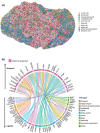Using single-cell multi-omics screening of human fetal pancreas to identify novel players in human beta cell development
- PMID: 36302085
- PMCID: PMC9828353
- DOI: 10.1111/dme.14992
Using single-cell multi-omics screening of human fetal pancreas to identify novel players in human beta cell development
Abstract
Islet transplantation from organ donors can considerably improve glucose homeostasis and well-being in individuals with type 1 diabetes, where the beta cells are destroyed by the autoimmune attack, but there are insufficient donor islets to make this a widespread therapy. Strategies are therefore being developed to generate unlimited amounts of insulin-producing beta cells from pluripotent stem cells, with the aim that they will be transplanted to treat diabetes. Whilst much progress has been made in recent years in the directed differentiation of pluripotent stem cells to beta-like cells, essential gaps still exist in generating stem cell-derived beta cells that are fully functional in vitro. This short review provides details of recent multi-'omics' studies of the human fetal pancreas, which are revealing granular information on the various cell types in the developing pancreas. It is anticipated that this fine mapping of the pancreatic cells at single-cell resolution will provide additional insights that can be utilised to reproducibly produce human beta cells in vitro that have the functional characteristics of beta cells within native human islets.
Keywords: beta cells; development; gene analysis; human pancreas; stem cells; transcription factors.
© 2022 The Authors. Diabetic Medicine published by John Wiley & Sons Ltd on behalf of Diabetes UK.
Conflict of interest statement
The authors declare that they have no conflict of interest.
Figures



References
Publication types
MeSH terms
Grants and funding
LinkOut - more resources
Full Text Sources
Medical

